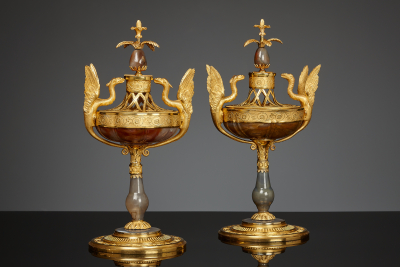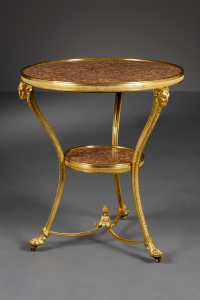Pair of Russian mounted agate coupes, Saint Petersburg
Pair of Russian mounted agate coupes, Saint Petersburg
A pair of agate coupes with pronounced gilt bronze mountings. The coupes each stand upon a round foot with a classic decoration of stylised acanthus leaves in rectangular cartouches all around. The upper section of the foot curves slightly inwards and incorporates a round plateau of blue agate upon which stands the stem. The point where the stem meets the plateau is decorated with a gilt bronze ornament in the shape of dependent acanthus leaves. Sprouting forth from this mounting, the baluster-shaped, blue agate stem is decorated by further gilt bronze mountings at the top. These carry the lobed, oval coupes, which are carved from red patterned agate. A bronze band with floral patterns runs around the entirety of the coupes. Attached to these on either side are elegant firebirds with open beaks and outstretched wings, their long curled tails following the contours of the coupes’ undersides to lean upon the bronze mountings below the coupes. These phoenixes, who give the impression of having been captured mid-flight, appear to bear the coupes aloft. The upper section of each coupe is covered by an openwork lid that extends into a second broad band at the top, which mimics the decoration of the band around the coupes. Above this, the lids are sealed by a carnelian disc, surmounted by an agate fruit topped with palm leaves and a half-open flower bud.
The carved agate coupes are good examples of recycling. They were probably produced in the east of what is now Germany, in the seventeenth century, and would most likely have been mounted at that time as well, using silver or gold mountings depending on the dictates of the currently prevailing fashion. Rare objects such as these were subsequently recycled to fit later fashions, resulting in new, exclusive objects.
One of the defining characteristics of paired agate objects was their extreme rarity. This was due, not only to the mineralogical character of the stone which is difficult to find in homogenous blocks, but mostly to the tremendous risk of fractures when attempting to carve the material to such a degree of fineness. It was extremely difficult to obtain two pieces of similar size, and the fact that these two objects can be displayed as a pair is therefore an exceptional achievement. The luxury agate objects form a link between science and visual art: they not only display the mineral and its geological properties, but also draw attention to its beauty, which – through the manner of its working and the purpose assigned to it – serves both to fulfil a functional need and to exhibit its aesthetic qualities. The bronze mountings provide the “stage” for the material to shine on, and accentuate the stone’s natural beauty.
In the latter half of the eighteenth century, the fascination with mineralogy in Russia had grown to such proportions that Catherine the Great deemed it a general disease. She viewed it as another fad that the wealthy of the day happened to be infatuated with, a passing fashion for collecting old stones – cut or raw – and in some cases having them mounted.
One such collector was Alexander Stroganov. When he had his palace on Nevsky Prospect refurbished in 1791, he had a sizeable cabinet of minerals added, his scientific interest in minerals extending into a love for decorative objects made from mineral materials. In 1800, Stroganov was made director of the Imperial Lapidary Works in Petergof, the first stone processing factory in Russia built at Peter the Great’s behest in 1721 near Saint Petersburg during the construction of Petergof park and palace. The factory specialised in the processing of small pieces of stone from the Ural and Altai mountains, and prompted a rekindling of the mineralogical fascination that was further stoked by collectors such as Stroganov. Wealthy collectors also purchased old cut stones in Europe to have them made into works of art intended not only for their own collections, but also for trade and as gifts to foreign diplomats.
A famous example of a foreign diplomat who was infected with the mineralogical craze in Russia was Alexander, 10th Duke of Hamilton, who served as the British Ambassador in Saint Petersburg in 1807 - 1808. Through gifts received and purchases made, he amassed a significant collection of cut stones, both mounted and unmounted, and decorated Hamilton Palace with them. In 1882, Christie’s organised a grand auction to sell off the palace’s top pieces, the collection being so large that the auction was divided over sixteen days. The Hamilton Palace Collection auction remains one of the auction house’s most famous and successful auctions to this day. Among the prize pieces were mounted objects, which were purchased by prominent collectors such as the Rothschilds, who had inherited a love for cut stones from the Russians towards the end of the nineteenth century.
Russian gilt bronze objects
In the late 18th century and the first quarter of the 19th century, the French style was immensely popular and found throughout Europe. The market for gilt bronze objects typical of the French style was so large that Parisian bronziers established workshops in major European cities, such as Berlin, Warsaw, Stockholm and Munich. However, despite the wealthy Russian nobility’s great appetite for the French style, it was impossible for the French bronziers to establish a foothold in Russia, as restrictions imposed by Paul I forbade Frenchmen from working in Russia. As a result, most bronzeworkers in Russia were of German or Swedish origin. Despite the absence of French bronziers in Russia, demand for French gilt bronze pieces was extremely high, and the severe import duties levied on objects from France raised their prices to dizzying levels. This resulted in a bustling black market trade in bronze objects smuggled from France into Russia.
Following his accession to the throne in 1801, Czar Alexander I cracked down on French contraband, while incentivising domestic bronze workshops through subsidy schemes. This resulted in the establishment of multiple new workshops, in which the bronzeworkers were given all the financial and artistic room they needed to develop themselves. However, most of these new businesses proved short-lived, due in part to the working methods employed in Russian workshops. Very few design drawings and sketches were made, as a result of which the bronzeworkers were largely working blind, as it were. An important exception to this rule was A.N. Voronikhin (1759-1814), who had trained in France and was therefore well-acquainted with the French style. He created a large variety of design drawings, whose clear style provided a solid point of reference for Russian bronzeworkers and thus laid the foundation for the budding and uniquely idiosyncratic Russian style. Another influential figure was the Swiss bronzeworker Pierre Marie Louis Agis (1752-1828), who worked for the State Stroganov Bronze Factory. Though his time with the factory was extremely short – less than a year – the state purchased all of his sketches, moulds and instruments when he departed, allowing Russian workers to draw inspiration from his artistic influence for many years to come. The factory was managed by A.F. Bestuzhev, a protégé of Count Stroganov, until 1810. Agis subsequently returned to run the factory until its bankruptcy in 1812.
- Provenance
- Galerie J. Kugel, Paris, 1997
Private collection, Amsterdam - Period
- ca. 1795
- Material
- agate, carnelian, gilt bronze
- Dimensions
- 33 x 17 cm
- Diameter
- 14.00 cm
Global shipping available










